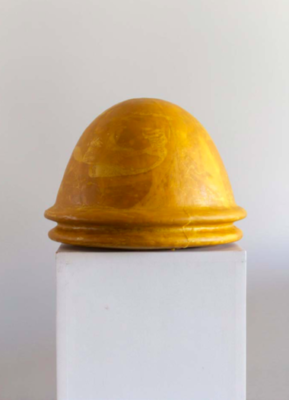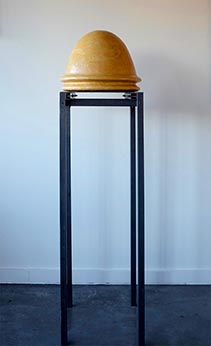We have to think about new materials, inspired by nature. We can experiment with a list of raw materials (list without limitation): corn starch, brown sugar, glutinous rice, coconut fibers, hemp, mushroom mycelium, silk, coffee ground, linen, cotton. We can e.g. cut old natural woven carpets with the lasercutter. We can dye raw materials with color extracts from plants as indigo (from the Indigofera tinctoria) or orange from the Calendula officials.
We can make hives out of flexible solar panels, or work with artificial materials issued from synthetic biology.
The models of the Intelligent Beehive are created from iterative processes where ideas are explored through the production of mock-ups. We do material studies, there are manual sketches and computer drawings: they all form an intrinsic part of the research towards the design of an Intelligent beehive.


The Golden Beehive is a sculpture made from the wax that the bees constructed in the frames of the Transparent Beehive. After an attack by the waxmot, the nest was destroyed and the bees left the hive. I cleaned the reaining wax and created the Golden Beehive, a sculpture that is a visual elegy for the bee colony of the Transparent Beehive.
the Golden Beehive (1520mm x 420mm x 420mm) – steel, plexiglass, beeswax
The hive is a system of homeostasis. Homeostasis is the property of a system that regulates its internal environment and tends to maintain a stable, constant condition of properties like temperature or pH. It can be either an open or closed system.
A medium sized nest needs 1200gr wax to be build, and 7,5 kg honey for the energy.
Beeswax is composed of more than 300 different chemical components.
The vertical comb construction is parallel to the earth magnetic field, the bees can construct this way thanks to the gravity receptors (organs) that are situated in all their legs and body joints.
The bees’ body is the basic template for the construction of a wax cell. From a cylindrical form the cells become hexagonal under the tension of the regurlarly constructed comb and heated by the bees’ bodyheath (cfr. soap bubbles joining together).
The wax wall of a cell is 0,07mm. The antennae of the bees measure the cells’ thickness.

Wax Beehive after biomimicry of Eucalyptus seedpod. The wax was carefully produced by my Brussels’ Honeybees.
The hive operates in a state of dynamic equilibrium. No central nervous system is available to the bees: each creature acts independently. It is essential that they have different thresholds, otherwise all behaviour would be all-or-none responses.
The result is a graded response, tuned into the needs of the larger entity (the body or the hive), always ready for a quick response.
(Animal Architects: building and the evolution of intelligence, James R. Gould)
The Wax Beehives were presented
– Alchimia Nova, solo Mulhouse Kunsthalle, 2023
– a Bee is a Bee, Palais de Tokyo, Paris , 2022
– Imagining Cities Beyond Technology 2.0, SongEun Gallery Seoul, South Korea, 2019
– as part of the Foraging Fields installation in the exhibition FIELDS, Riga – Latvia, from 15 may 2014 to august 4 2014.
– as part of the Café Europa Innovation Labs – Riga, from 1 sept. to 7 sept. 2014
– the Olfactory Container, october 2014, University Hasselt, Belgium
– in the Urban BEEing exhibition, Prague, november-december 2014
